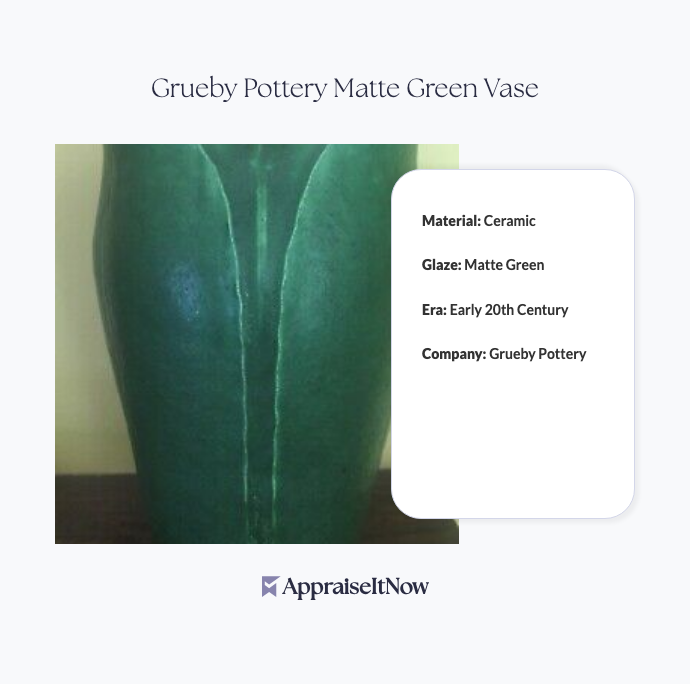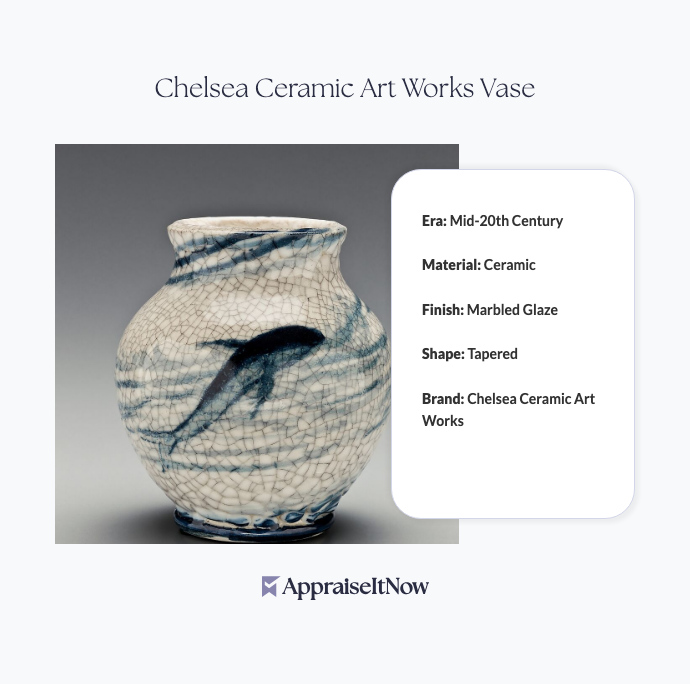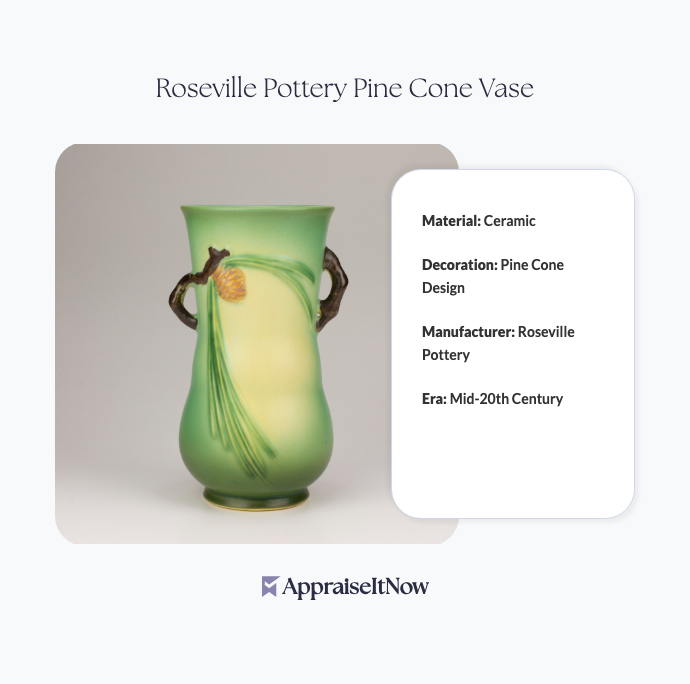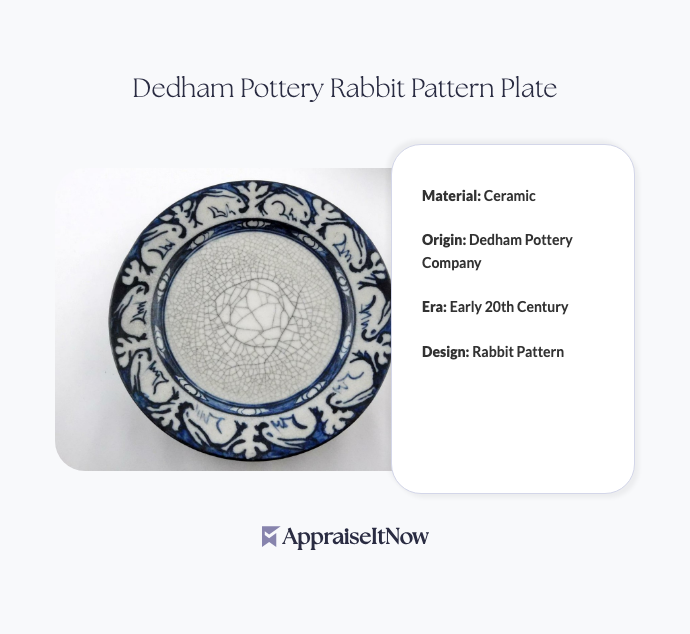<h1>How to Get Your Grueby Pottery Matte Green Vase Appraised</h1>
<p>The Grueby Pottery Matte Green Vase represents a pinnacle of American Arts and Crafts ceramics, commanding estimated market values between <strong>$3,000 and $4,000</strong> for quality examples. Whether you've inherited a piece from a family collection, discovered one at an estate sale, or are considering adding one to your <a href="/types/antiques">antiques</a> portfolio, understanding how professional appraisals work for these significant pieces ensures you make informed decisions about valuation, insurance, and potential sale.</p>
<h2>Understanding Grueby Pottery's Historical Context</h2>
<p>Your matte green vase carries the legacy of the <strong>Grueby Pottery Company</strong>, which operated in Boston from 1894 to 1913. The company earned international acclaim for pioneering the matte glaze technique—a revolutionary departure from the glossy finishes dominating Victorian ceramics. Grueby's distinctive matte green finish, inspired by the company's Arts and Crafts philosophy, became so influential that other manufacturers rushed to imitate it. This historical significance directly influences why professional appraisers value Grueby pieces so carefully.</p>
<p>What makes your vase particularly collectible? The combination of handcrafted quality, limited production runs, and the company's relatively brief operational window created a finite supply that collectors worldwide actively seek. When evaluating Grueby pottery for <a href="/types/artwork">artwork appraisals</a>, specialists look beyond simple age to assess artistic merit, craftsmanship, and market demand.</p>
<div class="callout tip"><p><strong>Collector's Insight</strong></p>
<p>Grueby vases with documented exhibition history or prominent provenance can command 30-50% premiums over standard examples in the $3,000-$4,000 range.</p></div>
<h2>What Distinguishes Authentic Grueby From Reproductions</h2>
<p>One of the critical questions appraisers address is authentication—ensuring your piece is genuinely Grueby rather than a contemporary reproduction or work from a similar maker. Understanding these distinctions prevents costly mistakes and establishes your vase's credibility in the market.</p>
<p>Authentic Grueby vases exhibit several distinguishing characteristics that professional appraisers examine closely. The glaze itself tells a story: genuine Grueby matte glaze displays subtle color variations and a characteristic texture that reproductions struggle to replicate convincingly. The form typically reflects the company's design philosophy—simple, elegant shapes without excessive ornamentation, allowing the glaze to serve as the primary artistic element.</p>
<p>Looking at physical markers, legitimate Grueby pieces often bear either impressed marks on the base reading "GRUEBY POTTERY BOSTON MASS" or occasionally artist signatures. The clay body shows telltale characteristics of early-20th-century American ceramics, including weight distribution and firing evidence that differs markedly from later reproductions. Similar makers including <strong>Van Briggle Pottery</strong>, <strong>Newcomb College Pottery</strong>, and <strong>Marblehead Pottery</strong> produced comparable matte glazes, which is why proper authentication requires specialized knowledge. Professional appraisers trained in <a href="/types/antique-artwork">antique artwork</a> evaluation possess the expertise to distinguish between Grueby originals and capable imitations.</p>
<div class="callout note"><p><strong>Authentication Alert</strong></p>
<p>Common forgeries often display suspiciously perfect glaze uniformity or bases that lack authentic wear patterns—two red flags appraisers immediately notice.</p></div>
<h2>Condition Factors and Their Impact on Value</h2>
<p>Your Grueby vase's condition significantly affects its appraised value, and understanding which condition issues matter most helps you assess what professional appraisers will discover during evaluation. Unlike some <a href="/types/memorabilia-and-collectibles">collectibles</a> where minor wear adds character, pottery condition involves specific technical considerations.</p>
<p>The most important assessment factors include crazing—fine crackling in the glaze surface caused by differential shrinkage between glaze and clay body. While minor crazing is common in early-20th-century ceramics and often expected, extensive crazing can reduce value by 15-25%. Chips, particularly on the rim or base, represent more serious concerns, potentially decreasing worth by 20-40% depending on size and visibility. Restoration work, whether historical repairs or modern conservation attempts, requires full disclosure and typically reduces value by 30-50% unless expertly executed and clearly documented.</p>
<p>Glaze wear presents a nuanced assessment. Light wear that reveals underlying clay in patterns consistent with age and use poses minimal concern—collectors often appreciate this evidence of authentic history. Heavy glaze loss, scratching, or areas suggesting aggressive cleaning demand more critical valuation adjustments. The vase's interior condition also matters; appraisers examine whether the piece shows appropriate aging inside, which confirms it hasn't been recently manufactured or heavily restored.</p>
<p>Professional appraisal reports documenting condition through detailed photography and written assessment become essential for establishing baseline values. This documentation proves invaluable when seeking insurance coverage, as adjusters need clear evidence of existing condition to process claims appropriately.</p>
<h2>Recent Auction Results and Market Pricing</h2>
<p>Understanding current market dynamics helps establish realistic expectations for your Grueby appraisal. Recent auction results provide crucial data points that professional appraisers use when developing valuations. Auction houses including <strong>Christie's</strong>, <strong>Sotheby's</strong>, and specialized dealers tracking American art pottery regularly document Grueby sales, creating a transparent market record.</p>
<p>Recent transactions show interesting patterns in the collectible pottery market. Quality Grueby matte green vases in excellent condition with documented provenance have sold within and occasionally above the $3,000-$4,000 estimate range, particularly when featured in themed auctions of American Arts and Crafts ceramics. Pieces with superior size (taller vases command premiums), exceptional glaze quality, or prominent artist signatures perform stronger. Conversely, smaller vases or those displaying significant condition issues typically settle at the lower end of market estimates.</p>
<p>The broader collectible ceramics market demonstrates that Grueby pieces appreciate steadily but not dramatically—typical annual appreciation ranges from 2-4% for quality examples in stable condition. This contrasts with investment-grade fine art that may appreciate faster but carries greater volatility. When considering whether your vase represents a sound investment, professional appraisals provide the documented foundation for tracking appreciation over time. Exploring our resource on <a href="/blog/exploring-the-role-of-regional-styles-in-art-appraisals-understanding-local-markets">evaluating comparable sales</a> helps you understand how regional factors influence collectible pottery values.</p>
<h2>How Provenance Documentation Affects Valuation</h2>
<p>If you possess documentation regarding your vase's ownership history—previous owners, exhibition records, dealer invoices, or purchase receipts—this provenance significantly strengthens its appraisal value. Collectors and institutions place substantial weight on documented history, viewing it as authentication and historical validation combined.</p>
<p>Strong provenance might include records showing the piece was exhibited at a museum, featured in a notable collection, or published in scholarly pottery references. Dealer documentation from recognized American art pottery specialists carries particular weight. Even family ownership history, while less formal, provides value when supported by photographs or correspondence dating the acquisition. Professional appraisers understand that provenance represents tangible evidence of a vase's legitimacy and cultural significance.</p>
<p>Conversely, pieces lacking any ownership documentation—particularly those acquired recently through unknown channels—may see modest valuation discounts (typically 10-15%) due to inability to definitively establish continuous ownership. This underscores why maintaining purchase receipts, insurance documents, and any historical records benefits your long-term interests. When preparing for appraisal, compile whatever documentation you possess, and don't underestimate family stories or historical context—appraisers are skilled at evaluating supportive evidence holistically.</p>
<h2>The Appraisal Report Types and Their Purposes</h2>
<p>Different appraisal report formats serve distinct purposes, and understanding which type suits your needs ensures you receive properly tailored documentation. When you contact AppraiseItNow or similar services, specialists will discuss your situation to recommend the appropriate report structure.</p>
<p><strong>Fair Market Value</strong> appraisals establish what a willing buyer would pay a willing seller in an open market, typically used for general reference and insurance purposes. <strong>Insurance Replacement Cost</strong> reports determine the expense of replacing your vase with comparable quality today, particularly important when updating homeowner's or specialty collection policies. <strong>Estate Tax Valuations</strong> follow specific IRS guidelines for inherited property documentation, crucial if your vase appears in an estate settlement. <strong>Auction Estimates</strong> project potential selling prices in public sales, valuable when you're considering consignment to a gallery or auction house.</p>
<p>Each report type involves different assessment criteria and market analysis approaches. Professional appraisers explain these distinctions clearly before beginning work. For Grueby pottery specifically, insurance replacement cost and fair market value reports prove most common, though estate situations frequently require formal tax valuations. The certification credentials of your appraiser matter significantly—seeking practitioners credentialed through organizations including the <strong>American Society of Appraisers (ASA)</strong>, <strong>International Society of Appraisers (ISA)</strong>, or <strong>American Appraisal Association (AAA)</strong> ensures your report meets professional standards recognized by insurers and legal institutions.</p>
<div class="callout tip"><p><strong>Report Selection</strong></p>
<p>When uncertain which appraisal type you need, discuss your specific situation with the appraiser—they'll recommend the most appropriate and cost-effective option for your circumstances.</p></div>
<h2>In-Person Versus Photo-Based Appraisals for Pottery</h2>
<p>A practical question many collectors ask is whether online photo-based appraisals can reliably value a Grueby vase without in-person inspection. The answer involves balancing convenience against comprehensive assessment.</p>
<p>Photo-based appraisals offer genuine advantages. They're typically faster and more affordable, useful for preliminary valuations or when geography limits access to local specialists. High-quality photographs showing multiple angles, detail shots of the base and mark, close-ups of glaze texture, and appropriate lighting can convey substantial information. For online services like AppraiseItNow that specialize in <a href="/types/personal-property">personal property</a> valuation, trained appraisers review photographs systematically to render preliminary assessments.</p>
<p>However, professional standards increasingly favor in-person inspection for high-value items. Pottery's tactile qualities—glaze texture, weight, clay body characteristics—communicate important authentication and condition information that photographs struggle to capture fully. Direct inspection allows appraisers to detect subtle crazing, examine interior surfaces, assess glaze color nuances under various lighting, and verify marks definitively. For a piece valued at $3,000-$4,000, investment in comprehensive in-person evaluation often proves worthwhile, particularly when legal or insurance documentation is essential.</p>
<p><strong>USPAP-compliant (Uniform Standards of Professional Appraisal Practice) defensible reports increasingly emphasize direct inspection</strong>, especially for items where authentication concerns exist. If your appraisal will support legal proceedings, insurance claims, or significant financial decisions, prioritize certified appraisers willing to personally examine your vase. This commitment to thoroughness ultimately protects both your interests and the credibility of the valuation.</p>
<h2>Choosing the Right Appraiser for Your Grueby Vase</h2>
<p>Selecting an appropriately qualified appraiser directly influences the accuracy and acceptance of your valuation. When evaluating potential specialists, look for specific credentials and experience in decorative arts or American ceramics.</p>
<p>Preferred certifications include those from the ASA, ISA, and AAA—organizations maintaining rigorous continuing education and ethics standards. Specialists should specifically reference experience appraising American art pottery, ideally mentioning Grueby familiarity or related makers like Van Briggle or Newcomb. Ask whether they're accustomed to preparing reports for insurance companies, auction houses, and estate purposes. Request references from past clients or examples of previous appraisals (with client permission).</p>
<p>Geography matters less than expertise. An appraiser 500 miles away with deep ceramics knowledge provides greater value than a local generalist unfamiliar with art pottery markets. Many qualified specialists now offer efficient remote consultations combined with in-person inspection when warranted. Our guidance on <a href="/blog/what-to-ask-when-choosing-an-antiques-appraiser">selecting qualified appraisers</a> provides comprehensive selection criteria. When price shopping, remember that the lowest bid often reflects experience limitations rather than genuine value. Expecting appraisals in the $300-$500 range for ceramic pieces is reasonable, with more extensive research justifying higher fees.</p>
<h2>Market Context and Investment Perspective</h2>
<p>Understanding broader collectible pottery trends contextualizes your Grueby vase's position in today's market. American art pottery—encompassing Grueby, Rookwood, Newcomb, Marblehead, and related makers—maintains steady collector interest with modest but consistent appreciation. This differs from contemporary fine art that experiences dramatic value fluctuations.</p>
<p>The demographic driving art pottery collecting has been aging, which creates interesting market dynamics. Younger collectors are discovering these ceramics, broadening the collector base and supporting value stability. Meanwhile, museum acquisitions and scholarly attention continue elevating Grueby's cultural significance. These factors suggest long-term value preservation, though spectacular appreciation isn't typical for decorative arts in this category. For collectors viewing their Grueby vase as both aesthetic object and investment, professional appraisals establish benchmarks for tracking appreciation and supporting insurance adequacy over time.</p>
<div class="callout note"><p><strong>Key Takeaway</strong></p>
<p>A certified appraisal of your Grueby Pottery Matte Green Vase provides essential documentation for insurance protection, accurate valuation in today's market, and defensible assessment of this significant Arts and Crafts piece. Professional appraisers combine historical expertise, market knowledge, and rigorous standards to establish your vase's true worth, whether you're buying, selling, or preserving it for future generations.</p></div>







.avif)







